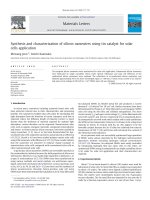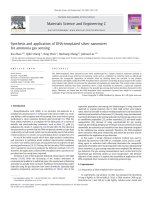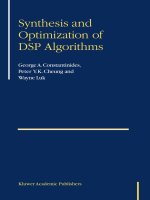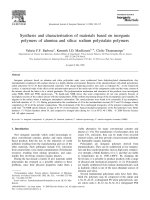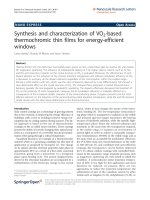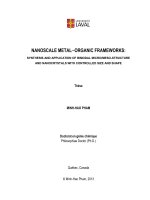Synthesis and application of graphene aerogel as an adsorbent for water treatment
Bạn đang xem bản rút gọn của tài liệu. Xem và tải ngay bản đầy đủ của tài liệu tại đây (970.52 KB, 6 trang )
Physical sciences | Chemistry
Doi: 10.31276/VJSTE.61(2).23-28
Synthesis and application of graphene aerogel
as an adsorbent for water treatment
Thi Lan Nguyen1, Tri Tin Nguyen1, Hoang Tu Tran1, Minh Dat Nguyen1, Huu Hieu Nguyen1, 2*
Key Laboratory of Chemical Engineering and Petroleum Processing
2
Faculty of Chemical Engineering
University of Technology - Vietnam National University, Ho Chi Minh city
1
Received 1 June 2018; accepted 1 August 2018
Abstract:
Introduction
In this research, graphene aerogel (GA) was
fabricated by chemical reduction method, in which
ethylenediamine (EDA) was used as a reducing and
functionalising agent. The characterisation of GA was
studied by density, field-emission scanning electron
microscope, Brunauer-Emmett-Teller (BET) specific
surface area, Fourier transform infrared spectroscopy,
and X-ray diffraction. The results of the analysis
showed that GA exhibits low density, ranging from
4-8 mg/cm3, high porosity, and BET specific surface
area changes from 176 to 1845 m2/g. It was found that
the suitable content of EDA on the synthesis of GA is
30 µl. The obtained GA was used as an adsorbent for
removal of oils and methylene blue (MB) from aqueous
solutions. The maximum adsorption capacities of GA
for lubricant and crude oils are 160 g/g and 110 g/g
respectively. The effecting factors including pH, contact
time, and initial concentrations on the adsorption
capacity of GA for MB were investigated. The
adsorption process of MB onto GA followed the pseudosecond-order kinetic and well-fitted to Langmuir
isotherm model. The maximum adsorption capacity for
MB from linear Langmuir model was calculated to be
212.76 mg/g at pH 7. Accordingly, GA could be used as
a potential adsorbent for removal of oils and MB from
water.
Water, an important resource in nature, has significant
impacts on the living conditions of creatures on the earth.
However, rapid industrialisation and urbanisation have
resulted in water pollution. The pollutants, such as metal ions,
oils, organic dyes, etc., are released into the environment,
which cause serious problems for the environment, humans,
and other organisms. Many methods have been developed,
such as adsorption, chemical oxidation, electrochemical,
biological, membrane separation, ion exchange, etc. for
removal of toxic contaminants from water. Adsorption
is one of widely used procedure for removal of pollution
from water. The traditional absorbent materials showed
low adsorption capacity and faced difficulty in separating
pollutants like activated carbon, zeolite, natural clays,
agricultural waste, biomass, polymeric, etc. [1, 2].
Keywords: chemical reduction, crude oil, graphene
aerogel, lubricant oil, methylene blue.
Classification number: 2.2.
Recently, graphene (Ge), a single atomic layer graphite,
has attracted great interest among scientists. Ge has unique
properties such as chemical stability, excellent mechanical
strength, high electrical and thermal conductivities and
good optical and large specific surface area. Ge is used in
many applications including catalyst, energy-storage and
environmental. However, Ge nanosheets tend to aggregate
and restack, leading to significant reduction of specific
surface area and application ability [3, 4]. To solve this
problem, three-dimensional (3D) graphene nanomaterials,
especially graphene aerogel (GA), are being developed.
GA has unique features like low weight, high porosity,
large surface area and chemical stabilities. Based on these
properties, GA materials have been considered as ideal
adsorbents for water treatment.
Several methods have been applied to synthesise
GA including 3D printing, cross-linking, hydrothermal
reduction, organic functionality and template-directing
method. However, these methods are difficult to control
in synthesis conditions, the research process of 3D-
*Corresponding author: Email:
JUne 2019 • Vol.61 Number 2
Vietnam Journal of Science,
Technology and Engineering
23
Physical Sciences | Chemistry
GA is limited [5-8]. In recent years, chemical reduction
method has developed benefits like simple, environmental
friendly, reduction at low temperature (T<1000C), and easy
scalability, which is why it is commonly used to synthesise
GA. The mild reduction agents such as acid ascorbic, sodium
ascorbate, ammoniac, urea, ethylenediamine (EDA), etc. are
widely used to synthesise GA. During the reduction process,
Graphene oxide (GO) was changed to reduced graphene
oxide (rGO) nanosheets, the electrostatic repulsion was
decreased. As a result the performance of self-assembly of
rGO was enhanced to form network structure [9, 10].
In this study, GA was synthesised by chemical reduction
method using EDA as a reducing agent. Effect of EDA
content on the synthesis of GA was studied. The structure
and morphology of GA were characterised by calculating
apparent density, field-emission scanning electron
microscope (SEM), Brunauer-Emmett-Teller (BET) specific
surface area, Fourier transform infrared spectroscopy
(FTIR), and X-ray diffraction (XRD). The obtained GA was
used as an adsorbent for removal of oils and methylene blue
(MB) from water.
Materials and methods
Materials
Graphite powder with an average particle size of 20
µm and EDA solution (99%) was purchased from Sigma
Aldrich, Germany. Potassium permanganate (99%), ethanol
(99%) and hydrogen peroxide (30%) were obtained from
VN Chemsol, Vietnam. Sulfuric acid (98%), phosphoric
acid (85%), hydrochloric acid (36%) and MB (99%) were
purchased from Xilong Chemical, China. Lubricant and
crude oils were supplied from Petrolimex, Vietnam. Twicedistilled water was used in all experiments.
Synthesis of GA
GO was synthesised using the improved Hummers
method as mentioned in our previous work [11]. In a typical
process, GO was dispersed into water with concentration
of 5 mg/ml. Then, different content of EDA was added to
GO suspension. The mixture was heated at 900C for 6 hours
to form graphene hydrogel (GH). Then, GH was immersed
and exchanged in ethanol and deionized water for at least
5 times to remove extra EDA and other impurities. Finally,
GH was sublimated at -600C for 48 hours to obtain GA.
The sample with EDA content of 15, 30, 45 and 60 µl are
labelled as GA15, GA30, GA45 and GA60.
Characterisation
The dimension of GA was measured by a caliper
(VOREL-15240, Germany) to calculate the volume. The
weight was determined by analytical balance (Sartoius
CPA225D, Germany). The density of GA is its mass per unit
volume, which was calculated using the following equation:
24
Vietnam Journal of Science,
Technology and Engineering
The dimension of GA was measured by a caliper (VOREL-15240, Ge
calculate the volume. The weight was determined by analytical balance
CPA225D, Germany). The density of GA is its mass per unit volume, w
calculated using the following equation:
(1)
3
3
where
is
the
density
(mg/cm
3), V is the volume (cm )
3 and m is weight (mg
where The
p is dimension
the density
(mg/cm
), V is the
volume
(cm
) and
of of
GAsamples
was measured
a caliper
(VOREL-15240,
Germany)
The
morphology
was by
studied
using
the FE-SEM
imaget
m iscalculate
weight
(mg)
of
GA.
the volume. The weight was determined by analytical balance (Sartoiu
Hitachi,
Japan). The surface area and pore volume of GA were determine
CPA225D, Germany). The density of GA is its mass per unit volume, which wa
The
morphology
of
samples
was studied
using the FEmethod
with
a Nova
1200e
instrument
(Quantachrome,
USA). The void-sp
calculated using
the following
equation:
SEM
images (S-4800,
surface is
area
was calculated
from poreHitachi,
volume Japan).
results. The porosity
a ratio of the void
(1
3 determined
3 equation
and
pore
volume
of
GA
were
by
BET
method
bulkwhere
volume
of
material,
which
was
obtained
from
(2). (mg) of GA.
is the density (mg/cm ), V is the volume (cm ) and m is weight
with a The
Nova
1200e instrument
The images (S-4800
morphology
of samples(Quantachrome,
was studied usingUSA).
the FE-SEM
Hitachi, Japan).
area and
pore
volume
of GA
were determined by BE
void-space
of GAThe
wassurface
calculated
from
pore
volume
results.
where iswith
the porosity
(%);
are the pore
volume
and the bulk
(Quantachrome,
USA).
The
Themethod
porosity is3aaNova
ratio1200e
of theinstrument
void-space
and bulk volume
of void-space of GA
materials
(cm
/g)
respectively.
FTIR
spectra
was
recorded
with
an Alphawas calculated from pore volume results. The porosity is a ratio of the void-space
an
material,
whichofwas
obtained
from
equation
(2).
bulk volume
material,
which
was obtained
from equation
(2).
(Brucker
Optik
GmbH,
Ettlingen,
Germany)
spectrometer
ranging
in wt
The dimension of-1GA was measured by a caliper (VOREL-15240, Germany)
from
500 tothe
4000
cm to
thewas
functional
groups
on the
mate
(2
(2) surface
calculate
volume.
Thestudy
weight
determined
by analytical
balance of
(Sartoiu
patterns
were
performed
on
an
X-ray
Diffusion
instrument
(D8
Advance
CPA225D,
Germany).
The
density
of
GA
is
its
mass
per
unit
volume,
which
wa
where is the porosity (%);
are the pore volume and the bulk volume o
and VT arewas
the recorded
pore volume
where
Ɛ is the
porosity
(%); Vequation:
3
vFTIR spectra
calculated
using
following
Germany).
materials (cm
/g)therespectively.
with an Alpha-E Brucke
3
and(Brucker
the
bulk
volume
of
materials
(cm
/g)
respectively.
Optik GmbH, Ettlingen, Germany) spectrometerFTIR
ranging in wavenumbe
(1
Oil adsorption
-1
3 the
3on(Brucker
from
500
4000
cm
to
study
functional
groups
themsurface
of materials.
XRD
spectra
was
recorded
with
an
), GA
VAlpha-E
is
the
(cm
) and
is weight
(mg)
of GA.
where
istothe
density
(mg/cm
The adsorption
capacity
of
forvolume
oilBrucker
was
determined
with
the help
of
patterns
wereEttlingen,
performed
on an X-ray
Diffusion
(D8
Brucke
The
morphology
samples
wasweighed
studied
using
the FE-SEM
images (S-4800
Optik
GmbH,
Germany)
spectrometer
ranging
in Advance,
method.
First,
the
GAofsample
was
(Winstrument
i) then put into crude or lub
Germany).
-1 pore volume of GA were determined by BET
Hitachi,
Japan).
The
surface
area
and
wavenumber
fromadsorbed,
500 to 4000
to study
the functional
After being
fully
the cm
sample
was taken
out. After removing oil
Oil adsorption
method
with a Nova 1200e instrument (Quantachrome, USA). The void-space of GA
groups
on
the
surface
of
materials.
XRD
patterns
were
the was
surface
with
filter
papers,
the
sample
was
weighted
(W
).ofThe
oilan
The
adsorption
capacity
of
GA
for
oil
was
determined
helpfvoid-space
the weigh
calculated from pore volume results. The porosity is a with
ratio the
of the
method.
First,
the
GA
sample
was
weighed
(W
)
then
put
into
crude
or
lubricant
oilm
performed
on
an
X-ray
Diffusion
instrument
(D8
Advance,
performance
was
reflected
by
the
saturated
adsorption
capacity
per
unit
i
bulk volume of material, which was obtained from equation (2).
being
fully adsorbed,
the sample
was
taken out.equation:
After removing oil residue o
GAAfter
samples,
which
was showed
by the
following
Brucker,
Germany).
(2
the surface with filter papers, the sample was weighted (Wf). The oil adsorptio
where
is thewas
porosity
(%);by the saturated
are the
pore volume
andper
the unit
bulkmass
volume
o
performance
reflected
adsorption
capacity
of th
Oil
adsorption
3
materials
(cmwhich
/g) respectively.
wasequation:
recorded with an Alpha-E Brucke
GA samples,
was showedFTIR
by thespectra
following
The adsorption
capacity
of GA
for
was
determined
(Brucker
GmbH,
Ettlingen,
Germany)
ranging
wavenumbe
where
isOptik
the adsorption
capacity
for oil
oil spectrometer
at saturated
state. in and
are
-1
from
500
to
4000
cm
to
study
the
functional
groups
on
the
surface
of
materials.
XRD
with
the
help
of
the
weight
method.
First,
the
GA
sample
and final weights (at adsorption saturation) of GA respectively [3, 12].
were
performed
aninto
X-ray
Diffusion
instrument
(D8and
Advance,
Brucker
where
is the
adsorption
capacity
for
oil ator
saturated
state. oils.
are the
initia
waspatterns
weighed
(W
) then on
put
crude
lubricant
Methylene
blue
i adsorption
Germany).
and
final
weights
(atexperiments
adsorption
saturation)
of GA
respectively
[3, 12].
After
being
fully
adsorbed,
the
sample
was
taken
out.
After
The
adsorption
were
conducted
to
study
adsorption
beha
Oil
adsorption
Methylene
blue adsorption
removing
oil residue
on adsorption.
the
with
papers, were
the
kinetics
process
of dyes
Batch
experiments
performed
by
The
of surface
GAwere
for oil
was filter
determined
the help
of the weigh
The adsorption
adsorption capacity
experiments
conducted
to studywith
adsorption
behaviour
an
First,
the
GA
sample
was
weighed
(W
)
then
put
into
crude
or
lubricant
oils
mgmethod.
of
adsorbent
into
20
ml
of
MB
solution
with
constant
shaking
(100
rpm
sample
was
weighted
(W
).
The
oil
adsorption
performance
i
kinetics process of dyes adsorption.
Batch experiments
were performed by adding 2
f
After
adsorbed,
sample
was taken
out.
After
removing
oil
residue
temperature
tofully
study
the
effects
ofsolution
contact
timeconstant
(time:
0-1440
min,
pH
6,room
Coo
was
by into
the
adsorption
capacity
per (100
mgreflected
ofbeing
adsorbent
20saturated
ml the
of MB
with
shaking
rpm)
at
the
surface
with
filter
papers,
thecontact
sample
was
weighted
(W
The
oil
adsorptio
f).initial
temperature
to
study
the
effects
of
time
(time:
0-1440
min,
pH
6,
C
200
mg/l
pH
values
(pH
3-10,
C
200
mg/l,
equilibrium
time),
and
concentrati
unitperformance
mass of the
GA
samples,
which was
showedcapacity
by theper unit mass
o
o
was
reflected
the saturated
adsorption
of th
pH
values
(pH
3-10,
Cotime,
200bymg/l,
equilibrium
time), and
initial concentration
(C
o 50
400GA
mg/l,
equilibrium
optimal
pH). After
adsorption
equilibrium,
th
following
equation:
samples,
which
was
showed
by
the
following
equation:
400 mg/l, equilibrium time, optimal pH). After adsorption equilibrium, the residua
concentration of MB was measured by UV-Vis spectrophotometer (Dual F
concentration of MB was measured by UV-Vis spectrophotometer
FL, Horiba
(3) (Dual
Japan)
at the wavelength of 664 nm. The adsorption capacity
( was calcu
Japan) at the wavelength of 664 nm. The adsorption capacity ( was calculated usin
thewhere
following
isequation:
the
adsorption capacity
capacity for
at saturated
state.state.
and
are the initia
where
qoil is the
adsorption
foroiloil
at saturated
the
following
equation:
and
final
weights
(at
adsorption
saturation)
of
GA
respectively
[3,
12].
Wi and Wf are the initial and final weights (at adsorption
Methylene blue adsorption
saturation)
of
GA
respectively
[3,
12].
The , adsorption
experiments
were
toand
study
adsorption
where
, are
are the
the
concentration
ofconducted
MBMB
before
after
the
adsorption,
is an
th
where
concentration
of
before
and
after
thebehaviour
adsorption
kinetics
process
of
dyes
adsorption.
Batch
experiments
were
performed
by
adding
2
volume
of
MB
solution
(ml)
and
m
is
the
weight
of
material
(mg).
Methylene
adsorption
volume
MB blue
solution
is the weight
of material (mg).
mgThe
ofof
adsorbent
into 20(ml)
mland
ofand
MBmsolution
with constant
(100 rpm)
at room
pseudo-first-order
pseudo-second-order
modelsshaking
were applied
to study
th
The
pseudo-first-order
and of
pseudo-second-order
models
were
to
temperature
to studyThe
theexperiments
effects
time
(time:
0-1440
min,
6, Capplied
o 200 mg/l)
adsorption
kinetic.
equation
ofcontact
models
are as
follows:
The
adsorption
were
conducted
topH
adsorption
The
models are
as and
follows:
pH valueskinetic.
(pH 3-10,
Co equation
200 mg/l, of
equilibrium
time),
initial concentration (Co 50
(5
study adsorption behaviour and kinetics process of dyes
400 mg/l, equilibrium time, optimal pH). After adsorption equilibrium, the residua
adsorption.
Batch
experiments
were
performed
by adding (Dual FL, Horiba
concentration
of MB
was measured
by UV-Vis
spectrophotometer
20 mg
of
adsorbent
into
20
ml
of
MB
solution
with
constant
Japan) at the wavelength of 664 nm. The adsorption capacity
( was calculated usin
the following
equation:
shaking
(100 rpm)
at room temperature to study the effects
of contact time (time: 0-1440 min, pH 6, Co 200 mg/l), pH
200
mg/l, equilibrium
time),
initial
values
(pH ,3-10,
o
where
areCthe
concentration
of MB before
andand
after
the adsorption, is th
50-400
mg/l,
equilibrium
time,
optimal
concentration
volume of MB(Csolution
(ml)
and
m
is
the
weight
of
material
(mg).
o
The pseudo-first-order
and pseudo-second-order
models were applied to study th
pH). After
adsorption equilibrium,
the residual concentration
adsorption
kinetic. The by
equation
of models
are as follows: (Dual
of MB
was measured
UV-Vis
spectrophotometer
(5
FL, Horiba, Japan) at the wavelength of 664 nm. The
adsorption capacity (q) was calculated using the following
equation:
JUne 2019 • Vol.61 Number 2
Methylene blue adsorption
The adsorption experiments were conducted to study adsorption behaviour and
kinetics process
of dyes adsorption.
Batch
were performed
bythe
adding
where
is the adsorption
capacity for
oil atexperiments
saturated state.
and
are
initial20
mgfinal
of adsorbent
into
20 ml ofsaturation)
MB solution
withrespectively
constant shaking
and
weights (at
adsorption
of GA
[3, 12].(100 rpm) at room
temperature
study
the effects of contact time (time: 0-1440 min, pH 6, Co 200 mg/l),
Methyleneto
blue
adsorption
pH
values
(pH 3-10,
Co 200 mg/l,
equilibrium
and initial
concentration
o 50The
adsorption
experiments
were
conductedtime),
to study
adsorption
behaviour(Cand
400 mg/l,
equilibrium
time, optimal
pH).experiments
After adsorption
equilibrium,
residual
kinetics
process
of dyes adsorption.
Batch
were performed
by the
adding
20
concentration
MB20was
by UV-Vis
spectrophotometer
(Dual
FL,at Horiba,
mg
of adsorbentofinto
ml measured
of MB solution
with constant
shaking (100
rpm)
room
Japan) at the
wavelength
of 664
Thetime
adsorption
capacitymin,
( pH
was6,calculated
using
temperature
to study
the effects
of nm.
contact
(time: 0-1440
Co 200 mg/l),
thevalues
following
equation:
pH
(pH 3-10,
Co 200 mg/l, equilibrium time), and initial concentration (Co 50400 mg/l, equilibrium time, optimal pH). After adsorption equilibrium,
the residual
(4)
(A)
concentration of MB was measured by UV-Vis spectrophotometer (Dual FL, Horiba,
where
,
are
the
concentration
of
MB
before
and
after
the
adsorption,
is the
where
, Cewavelength
are the concentration
MB before
and( after
Japan) C
at0the
of 664 nm. The of
adsorption
capacity
was calculated using
volume
of
MB
solution
(ml)
and
m
is
the
weight
of
material
(mg).
theadsorption,
following equation:
the
V is the volume of MB solution (ml) and m
The pseudo-first-order and pseudo-second-order models were applied to study the
is the
weight
of
material
(mg).of models are as follows:
adsorption kinetic.
The equation
where
,
are the concentration
of MB before and aftermodels
the adsorption, is the(5)
The pseudo-first-order
and pseudo-second-order
volume
of MB to
solution
m is the weight
of material
(mg).
were
applied
study(ml)
theand
adsorption
kinetic.
The equation
The pseudo-first-order and pseudo-second-order models were applied to study the
ofadsorption
models kinetic.
are as follows:
The equation of models are as follows:
(C)
(5)
(5)
Physical sciences | Chemistry
(B)
(D)
(6)
where
the amounts
of MB adsorbed
on the surface of GA at equilibrium
where
qe and qand
are theare
amounts
of MB adsorbed
on the surface
t
and
are
thek1pseudo-first-order and pseudoand
at
time
(mg/g)
respectively;
of GA at equilibrium and at time t (mg/g) respectively;
second-order
constant
respectively.
and k2 are the pseudo-first-order and pseudo-second-order
In order
to evaluate
the ofadsorption
capacity
of adsorbent,
the
experiment
was (A), GA30 (B), GA45 (C), and
constant
respectively.
Fig.
1.
SEM images data
of GA15
where
thethe
amounts
MB
adsorbed
thethe
surface
ofof
GA
at at
equilibrium
where and
and areare
amounts
of
MB
adsorbedonon
surface
GA
equilibrium
GA60
(D).
analysed
using
the
Langmuir
and
Freundlich
isotherms
models.
The
linear
equation
Fig.
1.
SEM
images
of
GA15
(A),
GA30
(B), GA45 (C), and GA60 (D).
and
are
the
pseudo-first-order
and
pseudoand
at
time
(mg/g)
respectively;
are of
theadsorbent,
pseudo-first-order and pseudoand
at time
(mg/g) respectively;
In order
to evaluate
the adsorptionand
capacity
second-order
constant
respectively.
models
were
presented
by the following equations:
second-order
constant
respectively.
FTIR
spectra: Fig. 2 shows the FTIR spectra of GO and
the In
experiment
data was analysed capacity
using the Langmuirthe
and
data
Inorder
ordertotoevaluate
evaluatethetheadsorption
adsorption capacityofofadsorbent,
adsorbent,
theexperiment
experiment
datawas
was
FTIR
spectra:
Fig.
2. shows thepeaks
FTIRof spectra
of GO
and GA. The characteris
GA.
The
characteristic
GO appear
at
Freundlich
isotherms
models.
The
linear
equation
models
analysed
models.
The
linear
equation
-1 1734, 1650,
analysedusing
usingthetheLangmuir
Langmuirand
andFreundlich
Freundlichisotherms
isotherms
models.
The
linear
equation
peaks
of
GO
appear
at
1734,
1650,
1229
and
1055
cm
corresponding
were
presented
by thebyfollowing
equations:
models
were
presented
thethe
following
equations:
1229 and 1055 cm-1 corresponding to C=O, C=C, C-O, to C=O, C=
models
were
presented
by
following
equations:
C-O, and C-O-C
groupsgroups
respectively
[3, 11].
solution treated w
and C-O-C
respectively
[3, For
11]. GO
For aqueous
GO aqueous
EDA,(7)
the characteristic peaks of C=O, C-O groups were decreased, and the new pea
solution treated -1with EDA, the characteristic peaks of
Ce isand
the 1190
concentration
of MB to the vibration of N-H and C-N grou
where: qm is the maximum uptake capacity (mg/g),
were (8)
1550
cm relating
C=O, C-O groups were decreased, and the new peaks were
solution at equilibrium (mg/l), and kl is the Langmuir
constant
(l/mg);
k
and
n
are the that the nucleophilic reaction between
respectively. These results
confirmed
f
1550 and
1190
cm-1 relating to the vibration of N-H and
maximum
uptake
capacity
(mg/g),
CeCis
thetheconcentration
ofofMB
where:
qmqmis isthe
the
maximum
uptake
capacity
(mg/g),
is
concentration
MB
where:
e
Freundlich
constants
[2,
13].
epoxide
in rGO and the amine group in EDA resulted in crosslink between
where
qmatisequilibrium
the maximum uptake
capacity (mg/g),
Ce is (l/mg);
the group
solution
n arearethethe
groups
respectively. These results confirmed that the
f kand
solution
at equilibrium(mg/l),
(mg/l),and
andkl kisl isthetheLangmuir
Langmuirconstant
constant
(l/mg);kC-N
f and
rGO
nanosheets
to nform
porous framework [15, 16].
concentration
of
MB
solution
at
equilibrium
(mg/l),
and
k
Freundlich
constants
[2,[2,
13].
Results
and
discussion
l
Freundlich
constants
13].
nucleophilic reaction between the epoxide group in rGO
isResults
the Langmuir
constant
(l/mg);
k
and
n
are
the
Freundlich
f
and
discussion
and the amine group in EDA resulted in crosslink between
Results
and
discussion
Characterisation
constants
[2,
13].
nanosheets to
Characterisation
Density of GA: the 3D-structure of GH was formed the
by rGO
self-assembling
ofform
rGOporous framework [15, 16].
Characterisation
Density
GA:
3D-structure
ofofGH
bybyself-assembling
ofofrGO
Density
of
GA:thethebonds,
3D-structure
GHwas
wasformed
formed
self-assembling
rGO
Results
andof
discussion
through
hydrogen
- interactions,
and Van
der
Waals forces
[9, 14]. Then, the
through
hydrogen
bonds,
-
interactions,
and
Van
derder
Waals
forces
[9,[9,
14].
Then, thethe
through
hydrogen
bonds,
-
interactions,
and
Van
Waals
forces
14].
freeze
drying process
was
conducted.
After
sublimation,
the Then,
content of water in
Characterisation
freeze
drying
freeze
dryingprocess
processwas
wasconducted.
conducted.After
Aftersublimation,
sublimation,thethecontent
contentofofwater
waterinin
structure
was
removed
but
the
morphology
of
GA
still
remained
with
very low density
structure
was
removed
butbut
thethe
morphology
ofof
GA
still
remained
with
very
low
density
structure
was
removed
morphology
GA
still
remained
with
very
low
density
Density
of
GA:
the
3D-structure
of
GH
was
formed
ranging
from
4
to
8
mg/cm
as
shown
in
Table
1.
ranging
from
4 to
8 mg/cm
asas
shown
inin
Table
1. 1.
ranging
from
4 to
8 mg/cm
shown
Table
by self-assembling of rGO through hydrogen bonds, π-π
Table
1. 1.
Density
GA.
interactions,
andofVan
Waals forces [9, 14]. Then, the
Table
of
GA.
Table
1.Density
Density
ofder
GA.
freeze drying process was conducted. After sublimation,
Sample
GA15
GA30
GA45
GA60
Sample
GA45
theSample
content of water GA15
in structure
was GA30
removed
but the
GA15 GA30
GA45GA60
GA60
3 3
morphology
of
GA
still
remained
with
very
low
density
p (mg/cm
)
6.37
4.57
6.76
7.95
p (mg/cm )3
6.37
4.57
6.76
7.95
p (mg/cm
4.57 1.
6.76
7.95
ranging
from )4 to 8 mg/cm6.37
as shown in Table
SEM
images:
the
porous
structure
ofofGA
was
asas
shown
inin
Fig.
1. 1.
AsAs
can
bebe
SEM
images:
porous
structure
GA
wasstudied
studied
shown
Fig.
can
Table
1. Density
ofthe
GA.
seen,
GA
3D3Dporous
structure
pore
seen,
GAwas
wasdescribed
described
usinga ahoneycomb-like
honeycomb-like
porous
structure
withthethe
pore
SEM
images:
the using
porous
structure
of GA
was
studied
as with
shown
in
Fig. 1. As can be
size
ranging
from
5-80
µm.
Among
that,
thethe
obtained
GA30
had
optimum
pore
size
ofof
size
ranging
from
5-80
µm.
Among
that,
obtained
GA30
had
optimum
pore
size
GA15
GA30
GA45
GA60
Sample
seen,
GA
was
described
using
a
honeycomb-like
3D
porous
structure
withand
theGA.
pore
Fig.
2.
FTIR
spectra
of
GO
thethenetwork,
network,which
whichis isthethehighest,
highest,approximate
approximatea ahundred
hundredmicrometres.
micrometres.This
Thispointed
pointed
size
ranging
from
5-80
µm.
Among
that,
the
obtained
GA30
had
optimum
pore
size
of
outoutthat
partial over-lapping
of coalescing ofofrGO
nanosheets occurred due to
that
rGO
3 the
) the partial
6.37 over-lapping
4.57 of coalescing
6.76
7.95 nanosheets occurred due to
p (mg/cm
2 2
partial
restoration
of
sp
regions,
π-π
stacking,
and
cross-linking
under
the
effect
of
patterns:
phases and interlayer spacing of GO and GA w
the
network,
which
the highest,
approximate
aXRD
hundred
micrometres.
partial
restoration
of sp isregions,
π-π stacking,
and cross-linking
under
the the
effectstructural
of This pointed
EDA,
leading
toto
the
formation
ofof
3D-architecture
[7,[7,
15].
EDA,
leading
the
formation
3D-architecture
15].
out
the
partial
over-lapping
of GA
coalescing
of rGO
nanosheets
occurred
due
to GO, XRD pattern shows a sharp peak at 2
studied
by XRD
as
shown
in
Fig.
3. For
SEMthat
images:
the
porous
structure
of
was
studied
as
Fig. 2. FTIR spectra of GO and GA.
2
o
partial
restoration
of be
sp seen,
regions,
and
cross-linking
underspacing
the effect
of Å. This result indicated the formation
10.6
with
an interlayer
is 8.32
shown
in Fig.
1. As can
GA π-π
was stacking,
described
using
XRDgroups
patterns:
structural
phases nanosheets.
and interlayer
EDA, leading to3D
theporous
formation
of 3D-architecture
[7,size
15].
oxygen-containing
on thethe
surface
of graphene
For GA, a wide pe
a honeycomb-like
structure
with the pore
spacing
of
GO
and
GA
were
studied
by
XRD
at 2θhad
= 23.65° appeared with an interlayer distance of 3.67 as
Å. shown
The interlayer distan
ranging from 5-80 µm. Among that, the obtained GA30
in Fig.
3. that
For of
GO,
XRD pattern
sharp peak
2θ that the oxyg
GA is larger
than
graphite
(3.4 Å),shows
whicha explains
theatfact
optimum pore size of the network, which is the of
highest,
0
approximate a hundred micrometres. This pointed out that = 10.6 with an interlayer spacing is 8.32 Å. This result
the partial over-lapping of coalescing of rGO nanosheets indicated the formation of oxygen-containing groups on
occurred due to partial restoration of sp2 regions, π-π the surface of graphene nanosheets. For GA, a wide peak at
stacking, and cross-linking under the effect of EDA, leading 2θ = 23.650 appeared with an interlayer distance of 3.67 Å.
The interlayer distance of GA is larger than that of graphite
to the formation of 3D-architecture [7, 15].
JUne 2019 • Vol.61 Number 2
Vietnam Journal of Science,
Technology and Engineering
25
Physical Sciences | Chemistry
(3.4 Å), which explains the fact that the oxygen-containing
functional groups on GO surface were partially reduced and
rGO self-assembled to form a 3D-architecture [15, 17, 18].
that GA has large pores and high surface area, resulting in
higher oil adsorption capacity [16].
Effect of conditions on methylene blue adsorption
Contact time: the effect of contact time was carried out
at initial concentrations of 200 mg/l as shown in Fig. 4.
The adsorption was increased rapidly at 240 mins and the
equilibrium was established after 480 mins. This suggests
that the network structure of GA with large area and volume
pores increased exposure and diffusion rate of MB for
adsorption sites on surface of GA.
Fig. 3. XRD pattern of Gi, GO, and GA.
BET specific surface area: BET was used to calculate the
specific surface area of GA, which is shown in Table 2. This
result can be explained by the self-assembly process of rGO
nanosheets to form interconnected structure with large pore
volume, leading to an increase in the surface area of GA
[19]. These BET results were in good agreement estimated
from the SEM images. GA30 had the specific surface area
of 1845 m2/g and the porosity of 98.06% was the selected
adsorbent for the following experimental adsorption.
Table 2. BET Specific surface area of GA.
Samples
GA15
GA30
GA45
GA60
Specific surface area (m2/g)
576
1845
285
176
Fig. 4. Effect of contact time on the adsorption of MB on GA.
The correlation coefficient (R2) from linear pseudosecond-order was closed to 1 (R2 = 0.9999) as shown in
Fig. 5. The adsorption process of MB into GA fitted well
with the pseudo-second-order kinetic.
Oil adsorption
Due to their light weight, high porosity structure, large
specific surface area and excellent hydrophobicity, GA
was used as an absorbent material for oils. The adsorption
efficiency of GA for lubricant and crude oils is shown in
Table 3.
Table 3. The adsorption capacities of GA for oils.
Sample
GA
Lubricant oil (g/g)
160
Crude oil (g/g)
110
The adsorption capacity of GA for lubricant oil 160 g/g
was larger than that for crude oil 110 g/g. The adsorption
capacity depends on density of oil and it was found that the
adsorption increases as per the density of the materials. The
results were in agreement with previous study suggesting
26
Vietnam Journal of Science,
Technology and Engineering
Fig. 5. The pseudo-second-order kinetic.
pH: Fig. 6 shows the effect of the initial pH on adsorption.
The uptake capacity enhanced with the increase in pH value and
reached the highest level at pH 7. The change of the capacity
may be π-π stacking and electrostatic interactions between the
functional groups on GA surface and MB [13, 18].
JUne 2019 • Vol.61 Number 2
Physical sciences | Chemistry
(A)
Fig. 6. Effect of pH on the adsorption of MB on GA.
Initial concentration: Fig. 7 shows the relationship
between adsorption capacity and initial MB concentration.
At low concentration (50-150 mg/l), the adsorption
capacity was rapidly increased and at higher concentration
(>150 mg/l) the adsorption capacity was slowly enhanced.
This phenomenon proved that the adsorption was almost
saturated.
(B)
Fig. 8. Langmuir (A) and Freunlich (B) isotherm models for
adsorption MB on GA.
Table 4. Maximum adsorption capacity (qm) of various adsorbent.
Adsorbent
qm (mg/g)
References
GA
212.76
Present work
Ge
100.0
[20]
TiO2 (P25) - GH
87.63
[21]
Conclusions
Fig. 7. Effect of initial concentration on the adsorption of MB
on GA.
The correlation coefficient from Langmuir model (R2
= 0.9979) was higher than that of Freundlich model (R2
= 0.9408) (Fig. 8). The adsorption process for MB into
GA was well-fitted to Langmuir isotherm model with the
maximum adsorption capacity of 212.76 mg/g.
The maximum adsorption capacity of MB on GA
compared with graphene-based materials is shown in Table
4. The results were higher compared to other materials,
which indicated that the interconnected porous structure
of GA increased the MB diffusion process, leading to
enhancement of the adsorption capacity.
In this study, GA was successfully synthesised by
chemical reduction method. SEM images showed selfassembly of reduced GO to form porous 3D framework.
FTIR, XRD and Raman results indicated that the oxygencontaining functional groups were partially reduced and GO
was transformed into rGO. It was found that the suitable
content of EDA for the synthesis of GA is 30 µl. GA had
the maximum adsorption capacities for lubricant and crude
oils, which were 160 g/g and 110 g/g respectively. The
equilibrium time for adsorption of MB into the GA was
480 mins. The adsorption process of MB on GA fitted to
the pseudo-second-order kinetic and Langmuir isotherm
model with the maximum capacity of 212.76 mg/g at pH
JUne 2019 • Vol.61 Number 2
Vietnam Journal of Science,
Technology and Engineering
27
Physical Sciences | Chemistry
7. Accordingly, GA could be considered as a promising
adsorbent for removal of oils and MB from water.
[10] K.X. Sheng, et al. (2011), “High-performance self-assembled
graphene hydrogels prepared by chemical reduction of graphene
oxide”, New Carbon Mater., 26, pp.9-15.
ACKNOWLEDGEMENTS
[11] D.C. Marcano, D.V. Kosynkin, J.M. Berlin, A. Sinitskii,
Z. Sun, A. Slesarev, Lawrence, B. Alemany, W. Lu, and J.M. Tour
(2010), “Improved synthesis of graphene oxide”, ACS Nano, 4(8),
pp.4806-4814.
The authors gratefully acknowledge the financial
support from the Ho Chi Minh city Department of Science
and Technology through the contract No. 234/2017/HDSKHCN.
The authors declare that there is no conflict of interest
regarding the publication of this article.
[12] C. Chi, H. Xu, K. Zhang, Y. Wang (2015), “3D hierarchical
porous graphene aerogels for highly improved adsorption and recycled
capacity”, Materials Science and Engineering B, 194, pp.62-67.
REFERENCES
[13] P. Wang, M. Cao, C. Wang (2014), “Kinetics and
thermodynamics of adsorption of methylene blue by a magnetic
graphene-carbon nanotube composite”, Applied Surface Science, 290,
pp.116-124.
[1] J. Huang and Z. Yan (2018), “Adsorption mechanism
of oil by resilient graphene aerogels from oil-water emulsion”,
Langmuir, 34(5), pp.1890-1898.
[14] Yangsu Xie, Shen Xu, Zaoli Xu, Hongchao Wu, Cheng Deng
(2016), “Interface-mediated extremely low thermal conductivity of
graphene aerogel”, Carbon, 98, pp.381-390.
[2] P.K. Malik (2004), “Dye removal from wastewater using
activated carbon developed from sawdust: adsorption equilibrium and
kinetics”, Journal of Hazardous Materials, 113(1), pp.81-88.
[15] X. Xu, H. Li, Q. Zhang, H. Hu (2015), “Self-sensing,
ultralight and conductive 3D Graphene/iron oxide aerogel elastomer
deformable in magnetic field”, ACS Nano, 9(4), pp.3969-3977.
[3] Y. Cheng, P. Xu, W. Zeng, C. Ling (2017), “Highly hydrophobic
and ultralight graphene aerogel as high eficiency oil absorbent
material”, Journal of Environmental Chemical Engineering, 5(2),
pp.1957-1963.
[16] Y.L. He, J.H. Li, J.B. Chen (2016), “The synergy reduction
and self-assembly of graphene oxide via gamma-ray irradiation in an
ethanediamine aqueous solution”, Nuclear Science and Techniques,
27, pp.61-69.
[4] T. Wu, M. Chen, L. Zhang, X. Xu, Y. Liu (2013), “Threedimensional graphene-based aerogels prepared by a self-assembly
process and its excellent catalytic and absorbing performance”, J.
Mater. Chem. A, 1, pp.7612-7621.
[17] J. Li, H. Meng, S. Xie, B. Zhang, L. Li (2014), “Ultra-light,
compressible and fire-resistant graphene aerogel as the highly efficient
and recyclable absorbent for organic liquids”, Journal of Materials
Chemistry A, 2, pp.2934-2941.
[5] M.A. Worsley, T.T. Olson, J.R.I. Lee, T.M. Willey (2011),
“High surface area, sp2-cross-linked three-dimensional graphene
monoliths”, J. Phys. Chem. Let., 8, pp.921-925.
[18] W. Si, X. Wu, J. Zhou, F. Guo, S. Zhuo (2013), “Reduced
graphene oxide aerogel with high-rate supercapacitive performance in
aqueous electrolytes”, Nanoscale Res. Lett., 8(1), pp.247.
[6] Y. Xu, et al. (2010), “Self-assembled graphene hydrogel via a
one step hydrothermal process”, ACS Nano, 4, pp.4324-4330.
[19] W. Wan, F. Zhang, S. Yu, R. Zhang (2016), “Hydrothermal
formation of graphene aerogel for oil sorption: the role of reducing
agent, reaction time and temperature”, New J. Chem., 40, pp.30403046.
[7] H. Sun, Z. Xu, C. Gao (2013), “Multifunctional, ultra-flweight,
synergistically assembled carbon aerogels”, Adv. Mater., 25, pp.25542560.
[8] G. Gorgolis, C. Galiotis (2017), “Graphene aerogels: a
review”, 2D Mater., 4, p.032001.
[9] W. Chen and L. Yan (2011), “In situ self-assembly of mild
chemical reduction graphene for three-dimensional architectures”,
Nanoscale, 3, pp.3132-3137.
28
Vietnam Journal of Science,
Technology and Engineering
[20] T. Liu, Y. Li, Q. Du (2012), “Adsorption of methylene
blue from aqueous solution by graphene”, Colloids and Surfaces B:
Biointerfaces, 90, pp.197-203.
[21] C. Hou, et al. (2012), “P25-graphene hydrogels: roomtemperature synthesis and application for removal of methylen
blue from aqueous solution”, Journal of Hazardous Materials, 206,
pp.229-235.
JUne 2019 • Vol.61 Number 2


